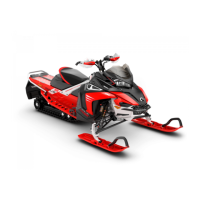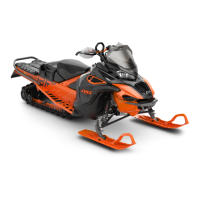RIDING THE VEHI CLE
Deep Snow
In deep “powder” snow, your vehicle could begin to “bog” down.
If this occurs, turn in as wide an arc as possible and look for a firm er
base. If you do get “bogged” , and it happens to everyone, do not
spin your track as this makes the vehicle sink deeper. Instead, turn
the engine off, get off and move the back o f the vehicle onto new
snow. Then tramp a clear path ahead of the vehicle. A few feet will
generally suffice. Restart the engine. Assume the standing position
and rock the vehicle gently as you steadily and slowly apply the
throttle. D epending on whether the front or rear end o f the vehicle
is sinking, your feet should be placed on the opposing end of the
running boards. Never place foreign m aterial beneath the track for
support. Do not allow anyone to stand in front of, or to the rear of,
the snowmobile with the engine running. Stay away from the track.
Personal injury will result if contact is m ad e with the revolving track.
Frozen Water
Traveling frozen lakes and rivers can be fatal. Avoid waterways. If
you are in an unfamiliar area, ask the local authorities or residents
about the ice condition, inlets, outlets, springs, fast moving currents
or other hazards. Never attempt to operate your snowmobile on ice
that may be t oo weak to support you and the vehicle. Operating a
snowmobile on ice or icy surfaces can be very dangerous if you do
not observe certain precautions. The very nature of ice is foreign to
good contro l of a snowmobile or any vehicle. Traction for starting,
turning or stopping is much less than that on snow. Thus, these
distances can be multiplied manyfold. Steering is minimal, and un-
controlled spins are an ever present danger. Wh en operating on ice,
drive slowly with caution. Allow yourself plenty of room for stopping
and turning. This is especially true at night.
Hard Packed Snow
Don't underestimate hard packed snow. It can be difficult to negoti-
ate as both skis and track do not have as much t raction. Best advice
is to slow down and avoid rapid acceleration, turning or braking.
Uphill
There are two types of hills you can encounter — the open hill on
which there are few trees, cliffs or other obstacles, and a hill that
can only be climbed directly. On an open hill, the approach is to
climb it by side hilling or slaloming. Ap proach at an angle. Adopt a
standing position with both feet on the same running board. Keep
____
SAFETY INFORMATION
___
29

